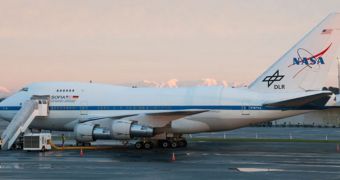The international collaboration of scientists managing the Stratospheric Observatory for Infrared Astronomy (SOFIA) mission announces the selection of no less than 51 science missions for the second full cycle of flights, scheduled to occur from February through December 2014.
SOFIA is the world's only infrared telescope mounted on an airplane, a heavily-modified Boeing 747SP. The aircraft is capable of climbing at cruise altitudes of up to 12,000 meters (39,000 feet). Its main feature is a 2.5-meter (100-inch) telescope protruding from its left flank.
The airplane has to fly at very high altitudes in order to avoid the obscuring layer of water vapor that permeates our planet's atmosphere. Infrared observations are very difficult to conduct from Earth's surface because of such interferences. In addition, mission profile dictates that the Boeing has to fly steadily and bump-free.
The airborne observatory is managed by a collaboration of scientists from NASA and the German Aerospace Center (DLR), through the SOFIA Science Center and the German SOFIA Institute (DSI), respectively. All those involved had a say in selecting the 51 missions that will use this telescope next year.
“More than 1,000 hours of observing time were requested, three times the amount available, evidence of SOFIA’s desirability to astronomers,” says the Science Missions Operations Director for SOFIA, expert Erick Young.
“The approved projects make good use of the observatory’s capabilities to study objects ranging from Earth’s solar system neighbors to galaxies hundreds of millions of light-years away,” he adds.
At this point, SOFIA is still engaged in its Cycle 1 science flights, having completed 23 of 30 planned missions as of November 5. For a few months, the aircraft was deployed to New Zealand, as part of its mission to study the sky above the Southern Hemisphere.
“In the past year, SOFIA has become a first-class asset to the world scientific community. Infrared studies from these observations will enhance our knowledge of the life cycles of stars, how planets form, the chemistry of the interstellar medium, and much more,” adds Pam Marcum, a SOFIA project scientist at NASA.
Designed as a replacement for the Kuiper Airborne Observatory, SOFIA saw first light on May 26, 2010. The aircraft is based at the NASA Dryden Aircraft Operations Facility, in California.

 14 DAY TRIAL //
14 DAY TRIAL //